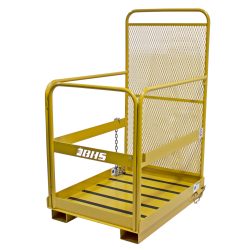We use cookies to make your experience better. To comply with the new e-Privacy directive, we need to ask for your consent to set the cookies. Learn more.
Safely Completing Inventory at the Top of Warehouse Shelves
At some point, usually at the end of the year, order pickers and warehouse managers alike have to buckle down and tackle inventory.
Manual inventory, while a chore, isn't really that tough for the first few tiers of shelving. Staff can easily kneel for the lower racks, take inventory up to eye level, and even climb short ladders to go above their heads.
But what about high-density shelving systems that take full advantage of a warehouse's vertical space? Lift truck forks can reach all the way to the top of high pallet racks, but getting staff up and down safely is another story altogether.

OSHA Rules Covering Forklift Work Platforms for Elevated Tasks
Rather than buying a dedicated personnel lift, like a cherry picker, you can convert a qualified forklift into an elevated work platform that goes as high as your lift truck's mast. Forklift Work Platforms (FWP) from BHS attach securely to forks to safely raise staff to the highest racks in the building. That’s a crucial ability when it’s time for inventory.
However, the Occupational Safety and Health Administration (OSHA) is very clear about how to go about using "Vehicle-Mounted Work Platforms," as it calls these handy devices. Here's what you need to know before this year's annual inventory rolls around, demanding access to the top of the racks:
-
CFR 1910.67(c)(iv) - "Employees shall always stand firmly on the floor of the basket, and shall not sit or climb on the edge of the basket or use planks, ladders, or other devices for a work position."
Hopefully this one is obvious. To encourage compliance and all-but-guarantee safety, the BHS FWP provides an anti-skid surface on the steel platform deck, plus high, 42" guard railings. The railing on the mast side is 66", with a steel mesh that's easy to see through, but totally protects workers from contact with the mast.
-
CFR 1910.67(c)(2)(v) - "A body belt shall be worn and a lanyard attached to the boom or basket when working from an aerial lift."
The key point here is to attach the belt to the basket or boom, not to an adjacent structure. Tying off to something outside the lifting device is prohibited by OSHA. Forklift Work Platforms from BHS include two points for safety harness attachment, so staff can pick the most convenient way to secure themselves to the basket.
-
CFR 1910.67(c)(2)(vii) - "The brakes shall be set and outriggers, when used, shall be positioned on pads or a solid surface. Wheel chocks shall be installed before using an aerial lift on an incline."
For optimum safety, it is recommended that warehouse aisles shouldn’t be on an incline. Be sure to stop and brake the lift truck before elevating personnel in a Forklift Work Platform at any angle.
-
1910.67(c)(5) - "'Welding standards.' All welding shall conform to...American Welding Society (AWS) Standards..."
Not only do Forklift Work Platforms comply with AWS standards for welds, they're made of heavy duty steel to keep staff safely contained. They also feature a scratch-resistant powder coating in high-visibility Safety Yellow.
For more information on OSHA's standards for lifting personnel, check out standards 1910.67 and 1926.1431. With a Forklift Work Platform, adequate training, and plenty of oversight, taking inventory at the highest levels of shelving can be as simple as counting units on the ground.
References:
“Vehicle Mounted Elevating and Rotating Work Platforms - 1910.67.” OSHA. Occupational Safety and Health Association, United States Department of Labor, n.d. Web. 3 July 2016.
“Hoisting Personnel - 1926.1431.” OSHA. Occupational Safety and Health Association, United States Department of Labor, n.d. Web. 3 July 2016.

